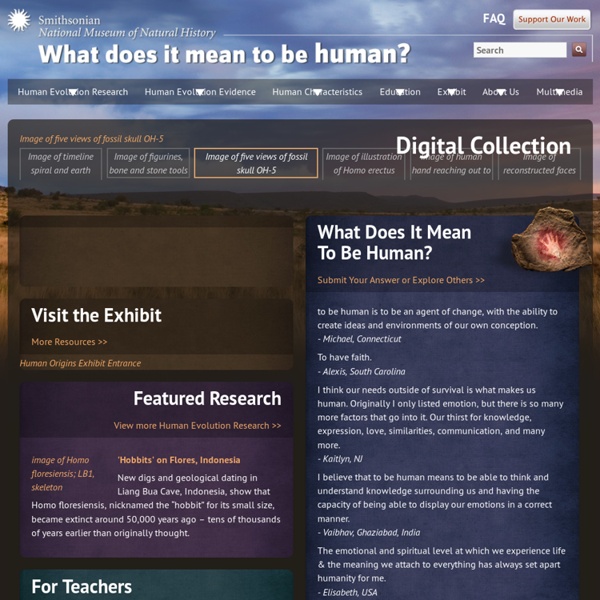



BioInteractive Search Results Series Where and when did humans arise? What distinguishes us from other species? The Mitochondrial Eve: Have Scientists Found the Mother of Us All? MHRC In 1987, A world wide survey of human mitochondrial DNA (mtDNA) was published by Cann, Stoneking, and Wilson in Nature magazine. Its main point was that "all mitochondrial DNAs stem from one woman" and that she probably lived around 200,000 years ago in Africa. When the media picked up from Wilson, one of the authors of the paper, that they had found the "Mitochondrial Eve" or "African Eve", the story became a sensation. Have scientists found "the mother of us all"?
Interactive Documentary Becoming Human is an interactive documentary experience that tells the story of our origins. Journey through four million years of human evolution with your guide, Donald Johanson. Transcripts are available in the following languages: English, Spanish, Italian, Chinese, and Sinhala. Please note: The Documentary has been converted to HTML5 - the Flash version has been retired. paleoanthropology, genetics, and evolution I have a review of Marlene Zuk's new book, Paleofantasy , in this week's Nature : "Evolutionary biology: Twisting the tale of human evolution" [1] . I can't replicate my review here, but for people who have access to Nature I thought I'd bring attention to it. And if you don't have access, I wanted to share a couple of my reactions.
BioInteractive Search Results Lectures How reasoning and evidence are used to understand human evolution. Genetic evidence shows that humans evolved in Africa and continue to evolve. No, a Mitochondrial "Eve" Is Not the First Female in a Species Recently, researchers made waves with the announcement that they had found the mother of all sperm whales: that is, the female from whom all modern sperm whales are descended. "Sperm Whales Have an ‘Eve,’” ran the news headlines, capitalizing on the biblical idea of the “first woman.” The idea of a mitochondrial "Eve” is not new; researchers often use it to refer to the first female genetic ancestor of a species.
Teaching About Evolution and the Nature of Science In a 1786 letter to a friend, Thomas Jefferson called for "the diffusion of knowledge among the people. No other sure foundation can be devised for the preservation of freedom and happiness."1 Jefferson saw clearly what has become increasingly evident since then: the fortunes of a nation rest on the ability of its citizens to understand and use information about the world around them. We are about to enter a century in which the United States will be even more dependent on science and technology than it has been in the past. Such a future demands a citizenry able to use many of the same skills that scientists use in their work—close observation, careful reasoning, and creative thinking based on what is known about the world.
100 Years of Breed “Improvement” For the sake of honest disclosure, I will admit to owning “purebreds” (the ‘pureness’ of purebreeds is a discussion for another time) but I also have mutts. All the dogs I’ve had since childhood had a few things in common, they were friendly, prey driven, ball-crazy, intense, motivated, athletic (crazy dogs are easier to train) and none had intentionally bred defects. I would never buy/adopt a dog whose breed characteristics exacted a health burden.
Introduction to Human Evolution Human evolution Human evolution is the lengthy process of change by which people originated from apelike ancestors. Scientific evidence shows that the physical and behavioral traits shared by all people originated from apelike ancestors and evolved over a period of approximately six million years. The Immortal Life « Rebecca Skloot Her name was Henrietta Lacks, but scientists know her as HeLa. She was a poor black tobacco farmer whose cells—taken without her knowledge in 1951—became one of the most important tools in medicine, vital for developing the polio vaccine, cloning, gene mapping, in vitro fertilization, and more. Henrietta’s cells have been bought and sold by the billions, yet she remains virtually unknown, and her family can’t afford health insurance. Soon to be made into an HBO movie by Oprah Winfrey and Alan Ball, this New York Times bestseller takes readers on an extraordinary journey, from the “colored” ward of Johns Hopkins Hospital in the 1950s to stark white laboratories with freezers filled with HeLa cells, from Henrietta’s small, dying hometown of Clover, Virginia, to East Baltimore today, where her children and grandchildren live and struggle with the legacy of her cells.
Cut and Run Legions of athletes, sports gurus, and scientists have tried to figure out why Kenyans dominate long-distance running. In this short, we stumble across a surprising, and sort of terrifying, explanation. At the 1968 summer Olympics in Mexico City, Kipchoge Keino overcame a gall bladder infection to win gold in the 1500 meter race. Since then, one particular group of Kenyans - the Kalenjin - has produced an astonishing number of great long-distance runners.
Ce site conçu par le Smithsonian Museum of Natural History propose plusieurs activités concernant spécifiquement l'évolution humaine. On y retrouve également un forum de discussion pour les enseignants en sciences. by manonalbert Feb 26